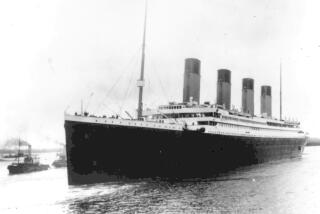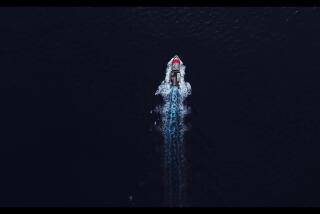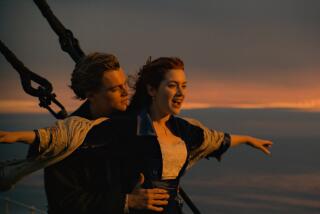Copper Kettle, Light Fixture Among Eerie Details : Explorer Gives a Video Tour of Titanic
WASHINGTON â Robert D. Ballard, chief explorer of the Titanic, led reporters on a dramatic guided photographic and video tour of the 74-year-old sunken luxury liner Wednesday, telling a hushed auditorium that âthe Titanic is protecting itselfâ from salvage by its severe decay.
âMost of the artifacts that would motivate people, I think, are not there,â said Ballard, leader of the scientific expedition that returned Monday after making 11 submarine dives to the wreck about 2 1/2 miles under the North Atlantic.
Except for a shiny two-foot-high bronze statue sighted near the bow--apparently of a Titan, one of the legendary Greek giants for whom the storied ship was named--Ballard said most of the visible debris is from third-class cabins and a kitchen in the broken stern area. Nearly all the shipâs once-ornate wood paneling and structures were eaten by wood-boring worms.
âOnly a Nubâ Remains
âTo see the whole wheelhouse eaten was very disappointing,â Ballard said. He said that âonly a nubâ remains.
The expedition provided the most detailed photos and first eyewitness accounts of the wreckâs condition since the Titanic, then the worldâs largest and most luxurious ship, hit an iceberg and sank on April 15, 1912, with a loss of more than 1,500 lives. The wreck was discovered last September.
Using a three-man mini-submarine and two remote-controlled submersibles, the scientists shot more than 57,000 photos and about 50 hours of videotape of the wreck and debris. The only artifact taken, a broken and rusted cable that accidentally lodged in one of the submersibleâs casing, was thrown back.
Ballardâs descriptive tour of the Titanic--augmented by a plastic shipâs model, several dozen slides and a five-minute video film--drew a standing-room-only crowd of more than 400 to the news conference at the National Geographic Society.
Close-up slides and videos showed in eerie detail how the shipâs once-gleaming hull is blanketed by what Ballard called ârivers of rustâ and stalactites of brilliant red, yellow and gold. The rust even formed âeyelashes or eyelids over the portholes,â he said.
Kettle Polished Clean
One slide showed a copper kettle, polished clean by ocean currents and particles in the water, sitting upright and surrounded by lumps of coal in the mud. Another slide showed a handrail and hanging light fixture outside the third officerâs cabin window. A video shot showed what appeared to be a small fish nibbling at the growth near a porthole. Another focused on the Titanicâs stern, where Ballard said, âtime has wiped its name away.â
The photos and video take on a murky blue tint as the distance increases. Ballard, an ebullient 44-year-old engineer and geologist, compared the problem of photographing the giant ship to âlooking at bark and trying to describe the forest.â
Holding up the plastic model, Ballard said the Titanicâs bow nose-dived into the bottom with such force that it âmade a shock wave in the sedimentâ and created an âimpact craterâ that buried the forward area up to 50 feet deep.
He said it was âvery puzzlingâ that none of the shipâs four 62-foot-long smoke stacks was found. He said the stacks may have drifted farther as they sank, or more likely, their thin steel plates had rusted more quickly.
Ballard repeated his finding that scientists found âabsolutely no evidenceâ of a suspected 300-foot-long gash where the iceberg hit the starboard bow. Instead, Ballard said the iceberg apparently sheared rivets from the steel hull plates and punctured others. âWhen you think about it, a snow cone trying to go through an inch of steel, maybe the gash was an overdone thing,â he said.
Surprised by Stern
Ballard said he also was surprised to find the shipâs stern broken off, 600 meters from the bow, and turned completely around. He said the stern now points in the same direction--north by northeast--as the better-preserved bow. In addition, the inner ribbing of the sternâs steel hull is âpeeled outwardâ and exposed, presumably from damage as the ship sank through the oceanâs crushing depths.
âThe bow was still majestic, the bow still had its nobility,â Ballard said. âThe stern was a carnage of debris. It just looked violent, torn and destructive.â
To some in the audience, Ballardâs description was an emotional journey to a gilded symbol of another age. Charles Haas, president of the Titanic Historical Society, said he got âshivers up my spineâ as the video showed the ship he has studied for about 25 years.
âIt was like meeting an old girlfriend with whom you corresponded for many, many years and this was our first face-to-face meeting,â he said. âIt was a very special feeling.â
More to Read
Sign up for Essential California
The most important California stories and recommendations in your inbox every morning.
You may occasionally receive promotional content from the Los Angeles Times.











